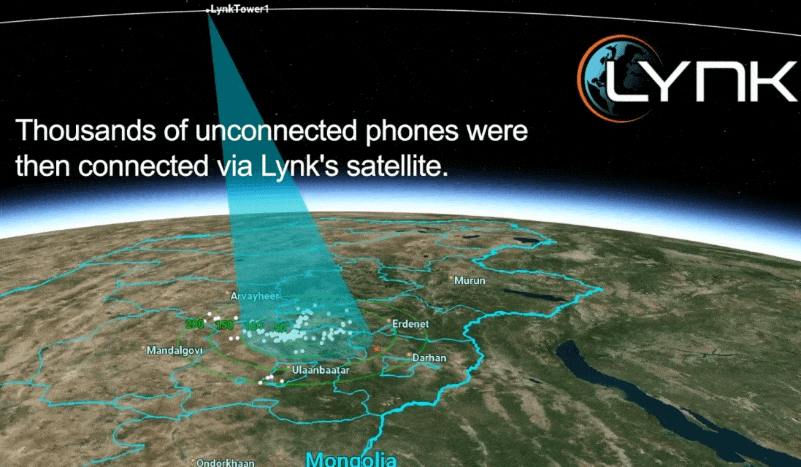SpaceX and T-Mobile may have hogged the headlines with their flashy pre-announcement about Starlink connectivity last month, and Apple last week, but Lynk has been putting in the work and may very well steal their lunch with a satellite-to-phone connection that already works — with any device out there. In fact, they just got FCC approval for it, meaning it’s just a matter of selecting a mobile network partner to bring it to market here in the States.
Lynk demonstrated a direct satellite-to-phone (and back) emergency connectivity service late last year with its test orbital cell tower. Far from an orbital broadband connection or a legacy satellite band that has you pointing your phone at an invisible dot in the sky, Lynk would provide intermittent (think every half hour or so) two-way SMS service via ordinary cellular bands that just happen to reach orbit. It’s intended for emergencies, check-ins from the back country and spreading information in places where networks are down, such as disaster zones.
It’s not easy to send a text to or from an antenna moving several thousand miles per hour, and CEO Charles Miller confirmed that it took a few years for them to make it happen. So when major companies say they’re working on it, he doesn’t feel too much heat.
“That’s the benefit of having invented the tech five years ago: There’s a bunch of hard things that no one else has done yet. I’m not saying they can’t, just that they haven’t yet,” he told me. “We validated this and patented it in 2017. We did it from space yesterday and the day before — we have the world’s only active cell tower in space.”
Of course, you could have a thousand of them and it wouldn’t matter unless you have regulatory approval and partners in the mobile space. That’s the next step for Lynk, and although they have 15 contracts spanning 36 countries around the world and are preparing for commercial launch, the United States FCC is the “gold standard” for this kind of testing and validation.
That’s not just because they have the best facilities — the FCC approval process is also the de facto battleground where companies attempt to run interference on one another. For instance, Hughes, which operates a number of communications satellites, objected to Lynk’s application on various grounds (which the FCC put down), and Amazon’s Kuiper requested Lynk share operational data with everyone else (not granted). One meaningful request partly agreed to came from the National Radio Astronomers Organization, which asked for various limits on operation, such as not polluting radio quiet zones.
There’s more than this one step with the FCC. Today’s order approves Lynk’s satellite services to operate in general, having showed that they will not interfere with other services, radio bands and so on. A separate approval will be needed when Lynk finds a partner to go to market with — but the more difficult and drawn out question of safety and interference is already answered.
And how will that go-to-market piece work? Lynk expects to offer commercial service elsewhere in the world, and Miller said he expects to convert testing licenses acquired in other countries into commercial ones, a process that mobile providers have to take the lead on. As for operating in the U.S., it’s the same thing.
But who will be Lynk’s partner, and what will the resulting service look like? Miller has said that whatever the commercial product looks like, Lynk will make its services available for emergencies to anyone — so you won’t be stuck in a blizzard just because you’re on the wrong network. It could also be used for blanketing an area with alerts or information regardless of signal, like telling victims of a natural disaster GPS coordinates of nearby shelters.

Visualization of a recent pass in Mongolia that connected with hundreds of ordinary phones. Image Credits: Lynk
Think about it like a roaming charge — if AT&T has coverage but you don’t have their network, they don’t stop you from calling 911 or even loading up TikTok, you just have to shell out later. And a 50-cent fee (or whatever it might be) is the last thing anyone will be thinking about when they sprain their ankle 20 miles from civilization.
Miller declined to comment on the competition, since really there isn’t any just yet — it’s all kind of theoretical. T-Mobile and Starlink’s service is still a twinkle in their eyes; AST SpaceMobile is gearing up for its first launch; Skylo is using geosynchronous satellites that work with specific devices; Apple’s likewise is only for its latest phones and the messaging capability is limited. Of course there are dedicated satellite messaging devices you can buy, but nothing beats the one you already have.
There’s no launch date set for availability in the U.S., and indeed Lynk will need to launch the rest of its 10-satellite constellation before it can offer the level of service it described to the FCC — but these days you can get a ride to space every week or two if you’ve got the money. So expect to hear more on this potentially life-saving service in the coming months, but don’t count on it for this ski season just yet.
